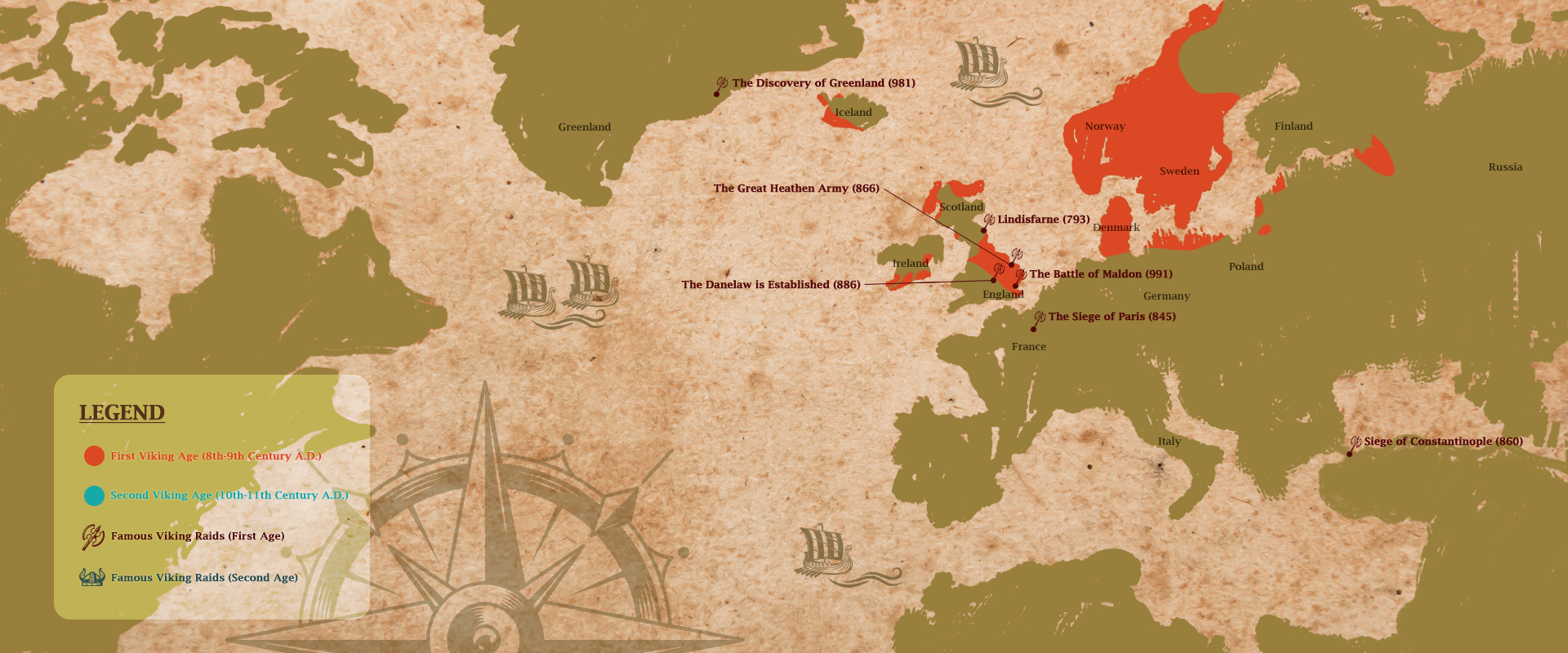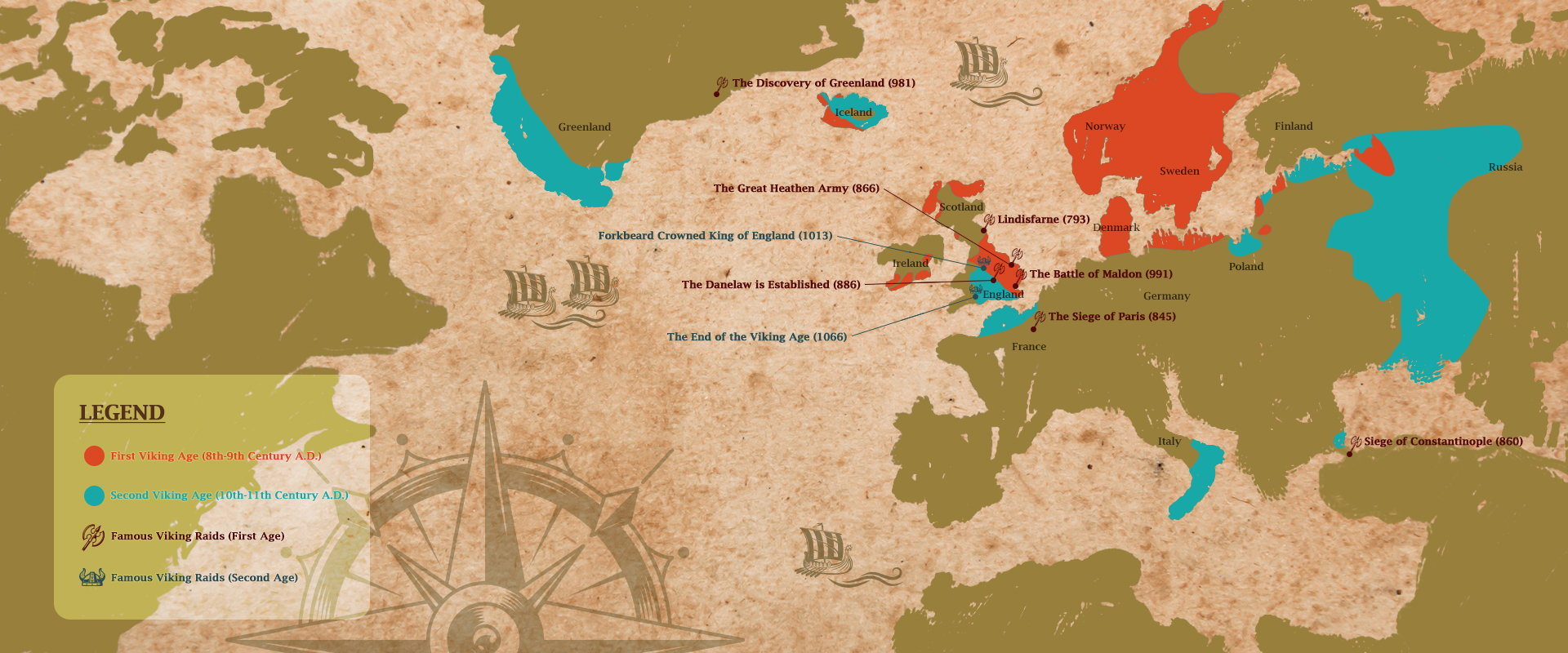Timeline of the Most Famous Viking Raids
Vikings. The mere word brings up all sorts of images that have been graven in popular culture: huge, hulking warriors clad in bearskins, wielding giant axes and wearing helmets with horns sticking out of them. Known and feared far and wide for their vicious raiding practices during the Middle Ages, these Scandinavian warriors might not have actually worn horned helmets all that much, if at all, but Viking raids were very real indeed. Here’s a timeline of some of the most famous of these raids throughout history.
First Viking Age

Lindisfarne (793)
On the 8th of June, 793, doom came to the Church of St. Cuthbert in Lindisfarne, situated in the north east of Britain on an island off the shores of Northumberland. For the first time ever, Viking raiding parties had appeared on English soil en masse, and the event sent repercussions through the entirety of Western Europe. The attack was physically and psychologically punishing for the region, leaving the survivors stunned and terrified. Sadly, this would be what was just the first of a number of Viking incursions – soon, Danes, Norsemen, and Vikings of all stripes would be knocking on Western Europe’s doors.
The Siege of Paris (845)
The Frankish Empire (modern-day France) were not immune from the predations of Viking raiding parties. A small skirmish in 799 led Charlemagne to construct fortifications to help repel these raids; these worked, for the most part, until well after his death. During the reign of Charles the Bald, a massive flotilla of more than 100 Viking longboats sacked the city on March 29th, Easter Sunday, and held the city ransom. They only left until being given their prize – 7,000 livres in silver and gold, the equivalent of roughly 83,000 troy ounces of precious metals. While the historical record isn’t completely clear, this famous raid was led by a Viking leader named Ragnar; it’s generally considered that this is the legendary Ragnar Lothbrok, but there is no hard evidence that this near-mythic figure in Viking history was truly the one leading the charge.
Siege of Constantinople (860)
Most associate Viking invasions of Western Europe during the Middle Ages as their most significant appearances. However, it was mostly Danish and Norwegian Vikings that sailed west; those who lived in what would become modern-day Sweden often went south and east, through Eastern Europe and modern-day Russia. Called the Rus, these Vikings would range as far south as Baghdad and even further; in the June of 860, the Rus launched a surprise raid on Constantinople, jewel of the East, burning and pillaging their way up and down the coastline and escaping with their spoils without even breaching the walls of the central city. Ironically, less than a century later 6,000 Viking troops known as the Varangian guard were hired to actually protect the city during times of war.
The Great Heathen Army (866)
One of the most influential moments in English history occurred in 866, when a massive horde of Vikings, mostly from Denmark, arrived on the shores of East Anglia. Led by the sons of Ragnar Lothbrok in the wake of his death and equally famous in their own rights, the masters of this giant invading army were Ubba, Halfdan Ragnarsson, Bjorn Ironside, and Ivar the Boneless. The Great Heathen Army invaded and occupied much of England, leading to conflict that would last for nearly a decade and a half. The spread of Vikings throughout the region was only halted due to the efforts of Alfred the Great, King of Wessex, when his armies defeated the Great Heathen Army in 878.
The Danelaw is Established (886)
While Alfred defeated the Great Heathen Army, at that point the entirety of eastern England had been conquered and colonized by Viking forces. Guthrum, the Viking that was leading the Army at that time, was given an offer he couldn’t refuse by Alfred: convert to Christianity, take the name Aethelstan, and be installed as the King of East Anglia. The result of this treaty, called the Danelaw, created a geopolitical boundary between Viking-held northeast England and Alfred’s holdings in southwest England. The Danelaw would remain in force until around 954, when Alfred’s daughter Aethelflaed led armies to re-conquer these regions, the cultural impact of the Danelaw can be felt to this day in England.
The Discovery of Greenland (981)
After being effectively ousted from England in the late 10th century, the Vikings set their sights elsewhere. While there would be a renewed interest in pillaging the eastern shores of England, more enterprising souls sought their fortunes westward – such as Erik Thorvaldsson, better known as “Erik the Red”, who is thought to be one of the primary historical figures behind the so-called “discovery” of Greenland and settlement there in 981. In truth, a Viking known as Gunnbjørn, son of Ulk Krake, had sighted the land nearly a century before but had not set foot there. Still, Erik the Red founded Viking colonies on the island which lasted for nearly half a century. Thanks to climate change leading to what’s known as the Little Ice Age, however, conditions on Greenland became too harsh for long-term survival.
The Battle of Maldon (991)
More than a century since the Great Heathen Army was defeated by King Alfred of Wessex, a new threat emerged: Danish King Swein Forkbeard. Gathering a massive army and landing in Kent in 991, Forkbeard began yet another conquest of England. This began with the Battle of Maldon, which had been famously immortalized in verse. Forkbeard was successful and began a reign of terror across the English countryside that, in less than 25 years, would become something altogether.
Second Viking Age

Forkbeard Crowned King of England (1013)
The dream of Ragnar Lothbrok and his sons finally came to fruition when Swein Forkbeard’s forces conquered all of England, culminating in the capturing of London. This deposed Athelred the Unready, forcing him into exile. Sadly, Swein Forkbeard would not live to reign very long over his new kingdom; he would die just five weeks later, kicking off an interregnum that saw much conflict between Viking forces and even saw Aethelred returning to the throne from 1014 to his death in 1016. It was then that Forkbeard’s son Cnut seized the throne, ruling for the next 19 years.
The End of the Viking Age (1066)
In 1066, the death of Edward the Confessor of the House of Wessex created a power vacuum. There was a play for the crown of England. Edward had regained the throne from Hardicnut, Cnut’s son and his own half-brother, but after his death the king of Norway, Harald Hadrada, claimed that Cnut had promised him the crown decades ago. Meanwhile Anglo-Saxon lord Harold Godwinson had been awarded the crown after the death of Edward, his brother-in-law, and met Harald in battle to defend his new kingdom, defeating Harald in a decisive victory. However, partly due to the exertion of fighting of Hardrada, Harold Godwinson was unprepared for an invasion of Norman troops led by William the Conqueror, and was famously slain at the Battle of Hastings that year. Thus did Viking and Anglo-Saxon rule of England come to an end, and with it the Viking Age in general.
References
- English Heritage. (n.d.). The Viking Raid on Lindisfarne. Retrieved July 15, 2021, from https://www.english-heritage.org.uk/visit/places/lindisfarne-priory/History/viking-raid/
- Weiss, D. (n.d.). The Viking Great Army. Archaeology Magazine. Retrieved July 15, 2021, from https://www.archaeology.org/issues/289-1803/features/6355-viking-great-army
- Mark, J. J. (2021, July 14). Viking Raids on Paris. World History Encyclopedia. https://www.worldhistory.org/Viking_Raids_on_Paris/
- Klein, C. (2018, October 19). Globetrotting Vikings: The Quest for Constantinople. HISTORY. https://www.history.com/news/globetrotting-vikings-the-quest-for-constantinople
- Cartwright, M. (2021, July 14). Varangian Guard. World History Encyclopedia. https://www.worldhistory.org/Varangian_Guard/
- When the Vikings ruled in Britain: A brief history of Danelaw. (n.d.). Sky HISTORY TV Channel. Retrieved July 15, 2021, from https://www.history.co.uk/articles/when-the-vikings-ruled-in-britain-a-brief-history-of-danelaw
- K. (2019, June 27). Discovery of Greenland. Polarpedia. https://polarpedia.eu/en/discovery-of-greenland/
- Oosthoek, J. K. (n.d.). Little Ice Age |. Environmental History Resources. Retrieved July 15, 2021, from https://www.eh-resources.org/little-ice-age/
- Battle of Maldon | Old English Poetry Project. (2021, April 5). Rutgers University. https://oldenglishpoetry.camden.rutgers.edu/battle-of-maldon/
- Sweyn Forkbeard. (n.d.). English History. Retrieved July 15, 2021, from https://englishhistory.net/vikings/sweyn-forkbeard/
- Harald Hardrada: The last Viking. (n.d.). Sky HISTORY TV Channel. Retrieved July 15, 2021, from https://www.history.co.uk/articles/harald-hardrada-the-last-viking
- BBC – History – Historic Figures: Harold II (Godwineson) (c.1020 – 1066). (n.d.). BBC History. Retrieved July 15, 2021, from http://www.bbc.co.uk/history/historic_figures/harold_ii_godwineson.shtml
- https://www.english-heritage.org.uk/visit/places/1066-battle-of-hastings-abbey-and-battlefield/history-and-stories/what-happened-battle-hastings/








